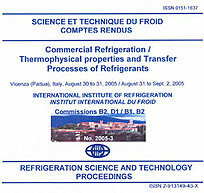
IIR document
A simulation and design tool for wire-and-tube condensers.
Author(s) : SCHWENTKER R. A., AUTE V. C., RADERMACHER R.
Summary
This paper introduces a simulation tool that can be used to design, model and optimize wire-and-tube condensers used in refrigeration appliances. The model is capable of accounting for natural convection and forced convection heat transfer on the air side. A segment-by-segment modelling approach within each tube is implemented to account for heterogeneous refrigerant flow patterns through the tubes and to account for two dimensional non-uniformity of air distribution across forced convection wire-and-tube condensers. The segment-by-segment approach also allows for the modelling of variable fin densities along the tubes. A subdivided segment model is developed in order to address the significant change of refrigerant properties that can take place between the single and two-phase flow regimes within a segment. A variety of working fluids can be modelled, and a variety of built-in correlations for heat transfer coefficient and friction factor are available. Object-oriented programming techniques are employed to create a highly flexible and customizable design platform, as well as a user-friendly graphic interface. The predictions of the model are verified using experimentally determined data for R134a.
Available documents
Format PDF
Pages: 2005-3
Available
Public price
20 €
Member price*
Free
* Best rate depending on membership category (see the detailed benefits of individual and corporate memberships).
Details
- Original title: A simulation and design tool for wire-and-tube condensers.
- Record ID : 2006-0720
- Languages: English
- Source: Commercial Refrigeration. Thermophysical Properties and Transfer Processes of Refrigerants. Proceedings of the IIR International Conferences.
- Publication date: 2005/08/30
Links
See other articles from the proceedings (140)
See the conference proceedings
-
Experimental study and thermal modelling of a R...
- Author(s) : LEDUCQ D., MACCHI-TEJEDA H., JABBOUR O., et al.
- Date : 2003/08/17
- Languages : English
- Source: 21st IIR International Congress of Refrigeration: Serving the Needs of Mankind.
- Formats : PDF
View record
-
Numerical study on the airflow uniformity and h...
- Author(s) : LEE T. S., WU W. C., WANG S. K., et al.
- Date : 2011/08/21
- Languages : English
- Source: Proceedings of the 23rd IIR International Congress of Refrigeration: Prague, Czech Republic, August 21-26, 2011. Overarching theme: Refrigeration for Sustainable Development.
- Formats : PDF
View record
-
Design optimisation of finned coils as condense...
- Author(s) : CAVAIONI P., DAL BELIN PERUFFO G., FORNASIERI E., et al.
- Date : 2005/08/02
- Languages : English
- Source: Commercial Refrigeration. Thermophysical Properties and Transfer Processes of Refrigerants. Proceedings of the IIR International Conferences.
- Formats : PDF
View record
-
IMPROVEMENT OF HEAT EXCHANGERS.
- Author(s) : TAGUCHI T., TANAKA J.
- Date : 1988/03/09
- Languages : English
View record
-
DYNAMIC MODEL OF REFRIGERATING SYSTEMS USING AI...
- Author(s) : COLDING L., et al.
- Date : 1991/08/10
- Languages : English
- Source: New challenges in refrigeration. Proceedings of the XVIIIth International Congress of Refrigeration, August 10-17, 1991, Montreal, Quebec, Canada.
- Formats : PDF
View record
